Black & White Film Processing Errors
There are a wide spectrum of black & white films available for photomicrography, ranging from traditional films with excellent spectral sensitivity throughout the visible light region to highly specialized technical films that have adjustable contrast depending upon exposure and development conditions. Almost all black & white films are designed to produce negatives from which prints are then made in the darkroom. Recently, several newer black & white films, termed chromogenic films that are processed with Kodak C-41 chemistry, have been introduced to take advantage of widespread automated commercial color negative processing horsepower.
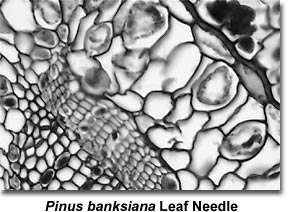
The specimen employed in this discussion is a brightfield black & white photomicrograph of a quadruple-stained thin section of a pine tree (Pinus banksiana) leaf needle. The stain mixture consists of safranin O (nuclei, chromosomes and cell walls), fast green (cytoplasm and cellulose cell walls), crystal violet (starch), and orange G (acidophilic cytoplasm). A Kodak Wratten No. 58 green filter was utilized to modulate contrast in the cell walls, which are heavily stained with fast green. The image was recorded on Kodak T-Max 100 film and processed in D-76 developer at the recommended time and temperature.
Although it is possible to process black & white negative films with only two chemicals, film developer and fixer, better results are obtained when recommended development procedures are adhered to using auxiliary solutions for a stop bath, clearing agent, and a wetting agent. The basic function of black & white developers is to process the latent image produced on the film emulsion by exposure to light. The developer interacts with exposed silver halide crystals embedded in the emulsion to convert them into particles of metallic silver, which forms the negative image. The concentration of silver in developed negatives is highest in those areas of the photomicrograph that have received the greatest amount of illumination, and is proportionately less in areas that have not been exposed as thoroughly. A certain level of action by the developer on unexposed silver halide crystals occurs in all black & white film and is termed fog density, but most commercial developing agents are designed to minimize this effect.
There are dozens of commercially available black & white film developers, many of which are general purpose, while others are intended to be used under a specific set of exposure and processing conditions for target films. Some developers are designed to produce finer-grain results than others and a few are formulated to provide high-contrast negatives. The most versatile developers allow contrast adjustment through mixing and development time and temperature variations.
In order to process black & white film, which is conveniently done in the laboratory with minimal darkroom requirements, the film must first be loaded into a suitable processing container in complete darkness. Development tanks that hold all available black & white film formats are commercially available at reasonable prices, and can usually be purchased locally in camera shops or variety discount supermarts. The most efficient development tanks include spools used to wind the film so that the emulsion side does not come into contact with the film base. After the film has been loaded into the tank, it is ready for processing. Pour a sufficient aliquot of premixed developer into the tank and agitate according to the manufacturers directions for the proper time and temperature. Next, drain the tank and wash thoroughly with either stop bath or tap water. The primary function of commercial stop bath solutions is to neutralize the developing agent, halting the development process and removing excess developer from the film surface. If salts, such as magnesium and calcium chloride, are present in the water (hard water), the stop bath will remove these also.
When the development process has been finished, the film is bathed in a solution of photographic fixer (sodium thiosulfate), a chemical designed to dissolve the undeveloped silver halide crystals still embedded within the film emulsion. A variation of the common fixer chemical is ammonium thiosulfate, which acts more quickly than the sodium analog and is the chief ingredient of quick or rapid fixers commonly used by amateur photographers. Fixer chemicals should only be used for the recommended time, because overprocessing of the film may result with incomplete washing and ultimately stain the negatives due to accumulation of excess fixer not completely removed by washing. In addition, overfixing may initiate dissolution of silver in low-density areas of the film and bleach the photograph, reducing overall film density.
After being exposed to the fixer solution, film must be washed for a time period of 20 to 30 minutes with agitation and a constant turnover of wash water. For best results, professional photographers treat processed film with a hypo clearing agent to speed removal of the fixer and allow more effective washing. Finally, the film is treated with a wetting agent to prevent wash water from beading on the emulsion surface and causing water spots or streaks on the film while drying. Excess water should be removed from the film with a squeegee, which will also help eliminate particles from the wash water and processing solutions that cling to the emulsion.
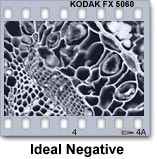 Examination of processed negatives is an important step in evaluating the results of photomicrography experiments. The first step is to carefully check the negatives for proper exposure and errors that may have been introduced by contrast filters. A properly exposed and processed negative is illustrated in the photomicrograph to the left. Exposure is even across the emulsion, details are sharp and have excellent contrast, and there are no obvious flaws arising from either photomicrography or processing errors. Negatives that are dense or dark have been overexposed, a condition that occurs when too much light reaches the film plane. This is not a film processing error, but rather demonstrates incorrect use of the microscope. Another common photomicrography error is underexposure, where the film density is very thin because not enough light has reached the film. These and other black & white photomicrography errors are thoroughly discussed in our section entitled Troubleshooting Black & White Film Errors, which describes common errors encountered in photomicrography using black & white film.
Examination of processed negatives is an important step in evaluating the results of photomicrography experiments. The first step is to carefully check the negatives for proper exposure and errors that may have been introduced by contrast filters. A properly exposed and processed negative is illustrated in the photomicrograph to the left. Exposure is even across the emulsion, details are sharp and have excellent contrast, and there are no obvious flaws arising from either photomicrography or processing errors. Negatives that are dense or dark have been overexposed, a condition that occurs when too much light reaches the film plane. This is not a film processing error, but rather demonstrates incorrect use of the microscope. Another common photomicrography error is underexposure, where the film density is very thin because not enough light has reached the film. These and other black & white photomicrography errors are thoroughly discussed in our section entitled Troubleshooting Black & White Film Errors, which describes common errors encountered in photomicrography using black & white film.
In many instances it is difficult to distinguish between errors that occur during processing and those that arise as a result of mishandling the microscope. Some errors are extremely subtle in nature, such as small contrast discrepancies and unusual density shifts, but others are often blatant. A variety of the most common errors encountered in black & white film processing are discussed in the paragraphs below with accompanying illustrations derived from photomicrographs of the specimen described above.
 Dark crescent-shaped marks (or "half-moons") can appear anywhere on the negative, including near the take-up spool sprocket perforations, and are due to mechanical wrinkling or creasing of the film. This error usually occurs during loading of film into the tank prior to processing or during removal of processed film from tank reels. The size of the mark is an indication of the severity of damage to the film base, especially when some of the emulsion has been removed. If the damaged area does not cover the entire negative, it may still be possible to get a usable print by cropping to include only good portions of the film during printing.
Dark crescent-shaped marks (or "half-moons") can appear anywhere on the negative, including near the take-up spool sprocket perforations, and are due to mechanical wrinkling or creasing of the film. This error usually occurs during loading of film into the tank prior to processing or during removal of processed film from tank reels. The size of the mark is an indication of the severity of damage to the film base, especially when some of the emulsion has been removed. If the damaged area does not cover the entire negative, it may still be possible to get a usable print by cropping to include only good portions of the film during printing.
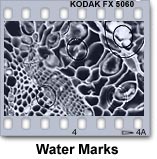 Water marks are light or dark gray spots that occur when water containing a significant amount of dissolved salts (hard water) dries on the emulsion surface. Careful use of hypo clearing agent or similar wetting agents followed by squeegeeing the film will help alleviate this problem, but will not guarantee a cure. Spots having a dark outline are caused by water coming into contact with the film surface after the emulsion has dried. This mistake usually occurs during cutting and packaging of the film and can be avoided by careful handling of film after processing and drying. Water marks can often be removed with film cleaner without compromising the integrity of the emulsion surface.
Water marks are light or dark gray spots that occur when water containing a significant amount of dissolved salts (hard water) dries on the emulsion surface. Careful use of hypo clearing agent or similar wetting agents followed by squeegeeing the film will help alleviate this problem, but will not guarantee a cure. Spots having a dark outline are caused by water coming into contact with the film surface after the emulsion has dried. This mistake usually occurs during cutting and packaging of the film and can be avoided by careful handling of film after processing and drying. Water marks can often be removed with film cleaner without compromising the integrity of the emulsion surface.
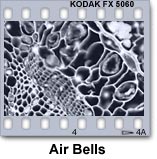 Air bells are circular clear spots that form in regions where the film developer was unable to reach the emulsion as a result of air bubbles clinging to the surface. The easiest way to avoid air bells is to gently tap the developing tank on the laboratory benchtop just after the developing solution has been added. In addition, the developing solution should be agitated according to the manufacturer's instructions during processing to dislodge any air bubbles that subsequently form on the film. On some occasions, air bells appear yellow when they occur during fixing, but proper agitation of the fixer will solve this problem.
Air bells are circular clear spots that form in regions where the film developer was unable to reach the emulsion as a result of air bubbles clinging to the surface. The easiest way to avoid air bells is to gently tap the developing tank on the laboratory benchtop just after the developing solution has been added. In addition, the developing solution should be agitated according to the manufacturer's instructions during processing to dislodge any air bubbles that subsequently form on the film. On some occasions, air bells appear yellow when they occur during fixing, but proper agitation of the fixer will solve this problem.
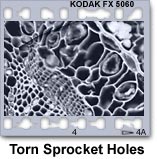 Torn sprocket holes can be an indication of a serious problem with the camera or darkroom procedures. Generally, damage to sprocket holes (the perforations used by the takeup spool to advance the film) occurs because of a problem in the camera advance mechanism. Frequently, the problem is caused by rewinding the film by force without first engaging the rewind mechanism (a button on the camera body). Another common cause of torn sprockets is trying to forcibly advance film after the end of the roll is reached. In many instances, the film is torn off the spool, compounding the problem. When the film has been mishandled during loading or unloading of the developing tank, damage to sprocket holes can also occur. This is because film is usually loaded into spiral grooves in a plastic or metal spool before being placed in the development tank. If the film is forced into the grooves or rapidly extracted, some damage can occur if one of the sprocket holes becomes caught in the reel or spool. To investigate this type of damage, carefully examine the camera back to determine if the problem lies with the takeup reel or some other portion of the film advance mechanism. If not, then review darkroom technique to see if it can be improved.
Torn sprocket holes can be an indication of a serious problem with the camera or darkroom procedures. Generally, damage to sprocket holes (the perforations used by the takeup spool to advance the film) occurs because of a problem in the camera advance mechanism. Frequently, the problem is caused by rewinding the film by force without first engaging the rewind mechanism (a button on the camera body). Another common cause of torn sprockets is trying to forcibly advance film after the end of the roll is reached. In many instances, the film is torn off the spool, compounding the problem. When the film has been mishandled during loading or unloading of the developing tank, damage to sprocket holes can also occur. This is because film is usually loaded into spiral grooves in a plastic or metal spool before being placed in the development tank. If the film is forced into the grooves or rapidly extracted, some damage can occur if one of the sprocket holes becomes caught in the reel or spool. To investigate this type of damage, carefully examine the camera back to determine if the problem lies with the takeup reel or some other portion of the film advance mechanism. If not, then review darkroom technique to see if it can be improved.
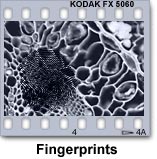 The presence of contaminating fingerprints on the emulsion will be obvious and is usually destructive to the film. Touching dry film with moist fingers is the usual source of this problem, but it can also occur during processing when the wet and soft emulsion surface is accidentally handled. If the fingerprints are due to developer solution, then resulting marks will be dark and usually impossible to remove. When the marks are caused by touching the film with fingers that are wet from fixer chemicals, then lighter colored fingerprints will be left on the emulsion that can sometimes be removed by thorough washing. To avoid fingerprints on film surfaces, rinse and dry hands after they have been exposed to chemical solutions and handle film by the edges, not the surface. Fingerprints due to grease and oils can sometimes be removed by rewashing film and treating it again with a wetting agent, or by cleaning the film with a cotton swab or film cleaner. Handling film with cotton editing gloves will avoid fingerprint problems.
The presence of contaminating fingerprints on the emulsion will be obvious and is usually destructive to the film. Touching dry film with moist fingers is the usual source of this problem, but it can also occur during processing when the wet and soft emulsion surface is accidentally handled. If the fingerprints are due to developer solution, then resulting marks will be dark and usually impossible to remove. When the marks are caused by touching the film with fingers that are wet from fixer chemicals, then lighter colored fingerprints will be left on the emulsion that can sometimes be removed by thorough washing. To avoid fingerprints on film surfaces, rinse and dry hands after they have been exposed to chemical solutions and handle film by the edges, not the surface. Fingerprints due to grease and oils can sometimes be removed by rewashing film and treating it again with a wetting agent, or by cleaning the film with a cotton swab or film cleaner. Handling film with cotton editing gloves will avoid fingerprint problems.
 Long thin scratches that run parallel to the length of a film strip are caused by tears and partial removal of the emulsion by mechanical force. This usually occurs during squeegeeing, but can also occur in the camera back or during processing. Check the film pressure plate on the camera back for damage or raised areas that might be scratching the film as it advances or rewinds. If the film has been forcefully loaded into the developing spool, sometimes the emulsion is rubbed too hard against the spool, causing blemishes. Film bulk loaders are often the source of scratched film, but this is usually not obvious until the film has been processed. If the error occurs repeatedly, then carefully examine film loading and darkroom technique to uncover the source of the problem. Film that has been damaged in this manner cannot generally be repaired, but one remedy (for printing purposes) is to gently rub some skin oils (from the forehead or nose) into the scratches for a quick fix. Eventually the oil will collect dust and should removed with film cleaner before storing the negatives.
Long thin scratches that run parallel to the length of a film strip are caused by tears and partial removal of the emulsion by mechanical force. This usually occurs during squeegeeing, but can also occur in the camera back or during processing. Check the film pressure plate on the camera back for damage or raised areas that might be scratching the film as it advances or rewinds. If the film has been forcefully loaded into the developing spool, sometimes the emulsion is rubbed too hard against the spool, causing blemishes. Film bulk loaders are often the source of scratched film, but this is usually not obvious until the film has been processed. If the error occurs repeatedly, then carefully examine film loading and darkroom technique to uncover the source of the problem. Film that has been damaged in this manner cannot generally be repaired, but one remedy (for printing purposes) is to gently rub some skin oils (from the forehead or nose) into the scratches for a quick fix. Eventually the oil will collect dust and should removed with film cleaner before storing the negatives.
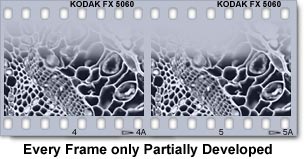 When every frame in a filmstrip has been only partially developed, then one edge of the entire roll will be lighter than the opposite edge. This occurs when there is not enough developer in the processing tank to completely immerse the film. To avoid the problem in the future, carefully measure the volume of liquid necessary to cover all film reels inside the developing tank and use this measurement to adjust developer solution volumes in subsequent processing sessions. Film that has been partially developed is permanently damaged and will only produce good prints if enough of the negative remains to allow satisfactory cropping.
When every frame in a filmstrip has been only partially developed, then one edge of the entire roll will be lighter than the opposite edge. This occurs when there is not enough developer in the processing tank to completely immerse the film. To avoid the problem in the future, carefully measure the volume of liquid necessary to cover all film reels inside the developing tank and use this measurement to adjust developer solution volumes in subsequent processing sessions. Film that has been partially developed is permanently damaged and will only produce good prints if enough of the negative remains to allow satisfactory cropping.
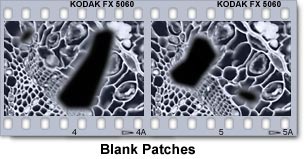 Large blank spots or patches on the emulsion surface are usually opaque to very dark in shade when viewed on negatives. Occasionally, blank patches will appear clear on the negatives, creating undesirable dark spots on resulting prints. The usual cause is two loops of film that have stuck together in the spool or reel during development. Often, to conserve space in developing tanks, photographers will stack several filmstrips together in the same reel, or will inadvertently wind two loops together on stainless steel reels.
Large blank spots or patches on the emulsion surface are usually opaque to very dark in shade when viewed on negatives. Occasionally, blank patches will appear clear on the negatives, creating undesirable dark spots on resulting prints. The usual cause is two loops of film that have stuck together in the spool or reel during development. Often, to conserve space in developing tanks, photographers will stack several filmstrips together in the same reel, or will inadvertently wind two loops together on stainless steel reels.
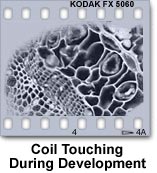 Squeezing reels too tightly in the developing tank can also cause film to overlap and touch. When this occurs, developing solution is prevented from reaching the film emulsion at the point of contact and the film will not be adequately processed. In most instances, the affected area will remain totally unprocessed and opaque, but can become clear if the film separates later in the development process. To avoid the problem, check to ensure film is winding correctly on the reel, and listen for crackling or other unusual sounds when loading film reels in the darkroom. If the winding doesn't proceed smoothly, unwind the film and start over again.
Squeezing reels too tightly in the developing tank can also cause film to overlap and touch. When this occurs, developing solution is prevented from reaching the film emulsion at the point of contact and the film will not be adequately processed. In most instances, the affected area will remain totally unprocessed and opaque, but can become clear if the film separates later in the development process. To avoid the problem, check to ensure film is winding correctly on the reel, and listen for crackling or other unusual sounds when loading film reels in the darkroom. If the winding doesn't proceed smoothly, unwind the film and start over again.
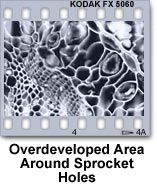 Repetitive streaks originating from the sprocket holes and traveling down into the emulsion are caused by too much agitation of the developer solution. The primary goal of agitating the developer solution is to ensure an even spread across the film surface and to continuously replenish depleted chemicals in the area immediately adjacent to the emulsion. Excessive agitation can force too much fresh developer into contact with the emulsion, causing an overdevelopment problem. The solution to this processing error is gentle, yet sufficient agitation of the film according to the manufacturer's specifications during processing. Overdeveloped film is often damaged beyond repair and should usually be discarded. Exceptions do occur however, and film that is not too overdeveloped can sometimes be printed satisfactorily.
Repetitive streaks originating from the sprocket holes and traveling down into the emulsion are caused by too much agitation of the developer solution. The primary goal of agitating the developer solution is to ensure an even spread across the film surface and to continuously replenish depleted chemicals in the area immediately adjacent to the emulsion. Excessive agitation can force too much fresh developer into contact with the emulsion, causing an overdevelopment problem. The solution to this processing error is gentle, yet sufficient agitation of the film according to the manufacturer's specifications during processing. Overdeveloped film is often damaged beyond repair and should usually be discarded. Exceptions do occur however, and film that is not too overdeveloped can sometimes be printed satisfactorily.
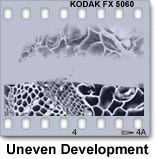 Uneven development is manifested by light streaks on the negative and is caused by insufficient agitation of the film developing solution. When the agitation level is not high enough, depleted chemicals near the emulsion surface are not replenished in time to complete the development process and can accumulate and slide across the film. This retards film development in large areas causing streaks that compromise the integrity of the negatives. Although film that is streaked cannot be repaired, future development sessions can be successful if the manufacturer's recommended agitation rates are followed. Negatives that have been streaked by uneven development usually yield unsatisfactory prints, but if the affected area is small, then judicious cropping can often produce a reasonable print.
Uneven development is manifested by light streaks on the negative and is caused by insufficient agitation of the film developing solution. When the agitation level is not high enough, depleted chemicals near the emulsion surface are not replenished in time to complete the development process and can accumulate and slide across the film. This retards film development in large areas causing streaks that compromise the integrity of the negatives. Although film that is streaked cannot be repaired, future development sessions can be successful if the manufacturer's recommended agitation rates are followed. Negatives that have been streaked by uneven development usually yield unsatisfactory prints, but if the affected area is small, then judicious cropping can often produce a reasonable print.
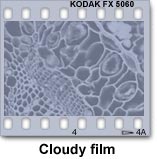 Cloudy film, a milky texture that occurs across the entire emulsion surface, is probably due to inadequate fixing. When the film is first removed from the developing tank, it should be carefully examined for processing errors. If the film appears cloudy, immediately place the film back into the development tank and load another batch of fixer. Agitate according to the manufacturer's directions for five minutes and reexamine the film. If it still appears cloudy, then the fixer is depleted or too old and should be replaced. There is plenty of time to prepare a fresh batch of fixer while the film is kept immersed in water. On some occasions, film that appears fogged or cloudy may have been permanently damaged by light leaks, heat exposure, or irradiation by X-rays at airport checkpoints. Laboratories that use radioactive chemicals capable of gamma radiation should also store and use film in locations far removed from radioactive chemical work areas.
Cloudy film, a milky texture that occurs across the entire emulsion surface, is probably due to inadequate fixing. When the film is first removed from the developing tank, it should be carefully examined for processing errors. If the film appears cloudy, immediately place the film back into the development tank and load another batch of fixer. Agitate according to the manufacturer's directions for five minutes and reexamine the film. If it still appears cloudy, then the fixer is depleted or too old and should be replaced. There is plenty of time to prepare a fresh batch of fixer while the film is kept immersed in water. On some occasions, film that appears fogged or cloudy may have been permanently damaged by light leaks, heat exposure, or irradiation by X-rays at airport checkpoints. Laboratories that use radioactive chemicals capable of gamma radiation should also store and use film in locations far removed from radioactive chemical work areas.
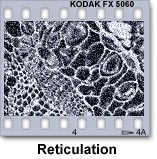 Reticulation occurs when film is exposed to extreme variations in processing temperature. The negative image appears "crinkled" or cracked throughout the surface and is damaged beyond repair. This error usually occurs when heated developer is inadvertently placed into the developing tank immediately after mixing. If the stop bath is too warm, reticulation can occur to a lesser degree. As the degree of reticulation is reduced (by using cooler solutions), the cracked surface is no longer a problem, but film grain size often becomes increased. The solution to this problem is to carefully monitor the temperature of all solutions used in the development process. On rare occasions, reticulation can lead to production of prints with some degree of artistic merit, but most negatives damaged in this manner yield unsatisfactory prints.
Reticulation occurs when film is exposed to extreme variations in processing temperature. The negative image appears "crinkled" or cracked throughout the surface and is damaged beyond repair. This error usually occurs when heated developer is inadvertently placed into the developing tank immediately after mixing. If the stop bath is too warm, reticulation can occur to a lesser degree. As the degree of reticulation is reduced (by using cooler solutions), the cracked surface is no longer a problem, but film grain size often becomes increased. The solution to this problem is to carefully monitor the temperature of all solutions used in the development process. On rare occasions, reticulation can lead to production of prints with some degree of artistic merit, but most negatives damaged in this manner yield unsatisfactory prints.
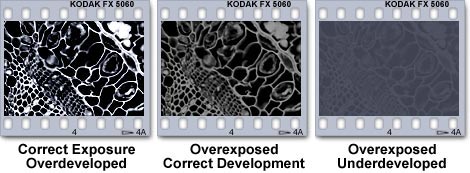
When negatives are very dense, they are probably overexposed and may be also overdeveloped. Overexposed film that has been properly processed will have a considerable amount of shadow detail and dense, blocked highlights. If correctly exposed film has been overdeveloped, the film will demonstrate normal shadow detail, with exceedingly dense and blocked highlights. Film in this condition will also have an excessive amount of contrast. If overexposed film is also underdeveloped, it will appear fogged with very dense shadow details and blocked highlights. These conditions usually result in unusable film.
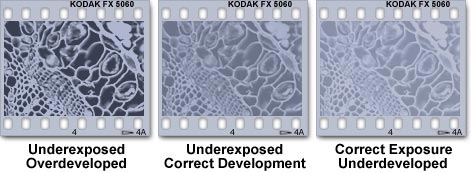
Very thin negatives are usually underexposed and yield very dark prints. Underexposed film has very little shadow detail and highlight areas tend to lose contrast. In fact, underexposure usually produces contrast problems regardless of attempts to compensate during development. Film that has been underexposed and underdeveloped regains some contrast, but is still lacking when compared to properly exposed and developed negatives. Underdeveloped film that has been exposed correctly will have normal detail in shadowed areas, but little highlight density and will suffer from low contrast.
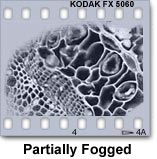 Fogging is the result of a light leak, either in the film development tank, darkroom (light leaking through the door, an inadequately blocked window, or a safelight), or in the camera back. Usually several frames are destroyed by fogging, but not the entire roll. Check all potential problem areas to ensure the mistake is not repeated with the next roll. Light leaks in the development tank can occur because the lid is not properly secured, or because the light-tight solution tube that runs through the center of the film reels is not seated properly. In rare cases, development tanks are cracked when they are slammed against the counter to dislodge air bubbles. Darkroom light leaks can be detected by turning off the lights and waiting for 15 minutes, allowing the eyes to become accustomed to the darkness before checking around door and window edges.
Fogging is the result of a light leak, either in the film development tank, darkroom (light leaking through the door, an inadequately blocked window, or a safelight), or in the camera back. Usually several frames are destroyed by fogging, but not the entire roll. Check all potential problem areas to ensure the mistake is not repeated with the next roll. Light leaks in the development tank can occur because the lid is not properly secured, or because the light-tight solution tube that runs through the center of the film reels is not seated properly. In rare cases, development tanks are cracked when they are slammed against the counter to dislodge air bubbles. Darkroom light leaks can be detected by turning off the lights and waiting for 15 minutes, allowing the eyes to become accustomed to the darkness before checking around door and window edges.
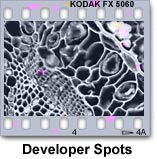 Purple or brown stains on the negative are usually caused by particles of developer that have precipitated onto the film base or emulsion during development. This error is caused by inadequate mixing of the developer solution during preparation, leaving a substantial amount of undissolved chemical. In some cases, thorough fixing can eliminate this problem or at least render the negatives usable. To circumvent the problem, always completely mix the developer before using and check to see if undissolved particles remain (they will usually settle to the bottom of the container).
Purple or brown stains on the negative are usually caused by particles of developer that have precipitated onto the film base or emulsion during development. This error is caused by inadequate mixing of the developer solution during preparation, leaving a substantial amount of undissolved chemical. In some cases, thorough fixing can eliminate this problem or at least render the negatives usable. To circumvent the problem, always completely mix the developer before using and check to see if undissolved particles remain (they will usually settle to the bottom of the container).
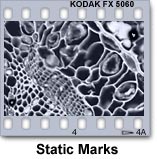 Static marks occur when film is unrolled too quickly in a darkroom under conditions of extreme low humidity, usually during the winter season. They appear as scratches, spots, or lightning-like black lines caused by static electricity that is prevalent in dry conditions. Static marks can also be caused inside the camera back or in bulk loaders when film is advanced or rewound too rapidly in dry weather. To avoid this problem, always take precautions when loading or unloading cameras and developing tanks when the relative humidity drops below 35 percent, especially in high pressure areas. Film, whether processed or unprocessed, should always be handled carefully using cloth gloves to avoid static discharge and other forms of mechanical and chemical damage.
Static marks occur when film is unrolled too quickly in a darkroom under conditions of extreme low humidity, usually during the winter season. They appear as scratches, spots, or lightning-like black lines caused by static electricity that is prevalent in dry conditions. Static marks can also be caused inside the camera back or in bulk loaders when film is advanced or rewound too rapidly in dry weather. To avoid this problem, always take precautions when loading or unloading cameras and developing tanks when the relative humidity drops below 35 percent, especially in high pressure areas. Film, whether processed or unprocessed, should always be handled carefully using cloth gloves to avoid static discharge and other forms of mechanical and chemical damage.
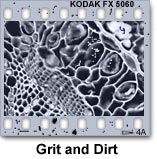 Grit and dirt on the negative surface is usually caused by inadequate washing or improper use of wetting agents. Make certain that wash water circulates well and is replenished often, and that wetting agents are properly diluted (they can leave a residue when used too concentrated). Damp film readily attracts dust and dirt, so thoroughly dry film before handling. Areas that have extremely hard water are prone to this type of problem. Filtering water before using it for photography processing is always a good idea, but in areas with hard water, it can become critical. When using commercial wetting agents, mix them with distilled water for the best results.
Grit and dirt on the negative surface is usually caused by inadequate washing or improper use of wetting agents. Make certain that wash water circulates well and is replenished often, and that wetting agents are properly diluted (they can leave a residue when used too concentrated). Damp film readily attracts dust and dirt, so thoroughly dry film before handling. Areas that have extremely hard water are prone to this type of problem. Filtering water before using it for photography processing is always a good idea, but in areas with hard water, it can become critical. When using commercial wetting agents, mix them with distilled water for the best results.
Processing black & white film is relatively easy when the basic instructions are followed, and the technique requires little in the way of experience. Furthermore, this film is relatively forgiving of lax development times and temperatures, provided the deviations are not taken to an extreme. With practice, any serious microscopist can become an expert in the art of black & white photography and produce photomicrographs that show exquisite detail and clarity.
